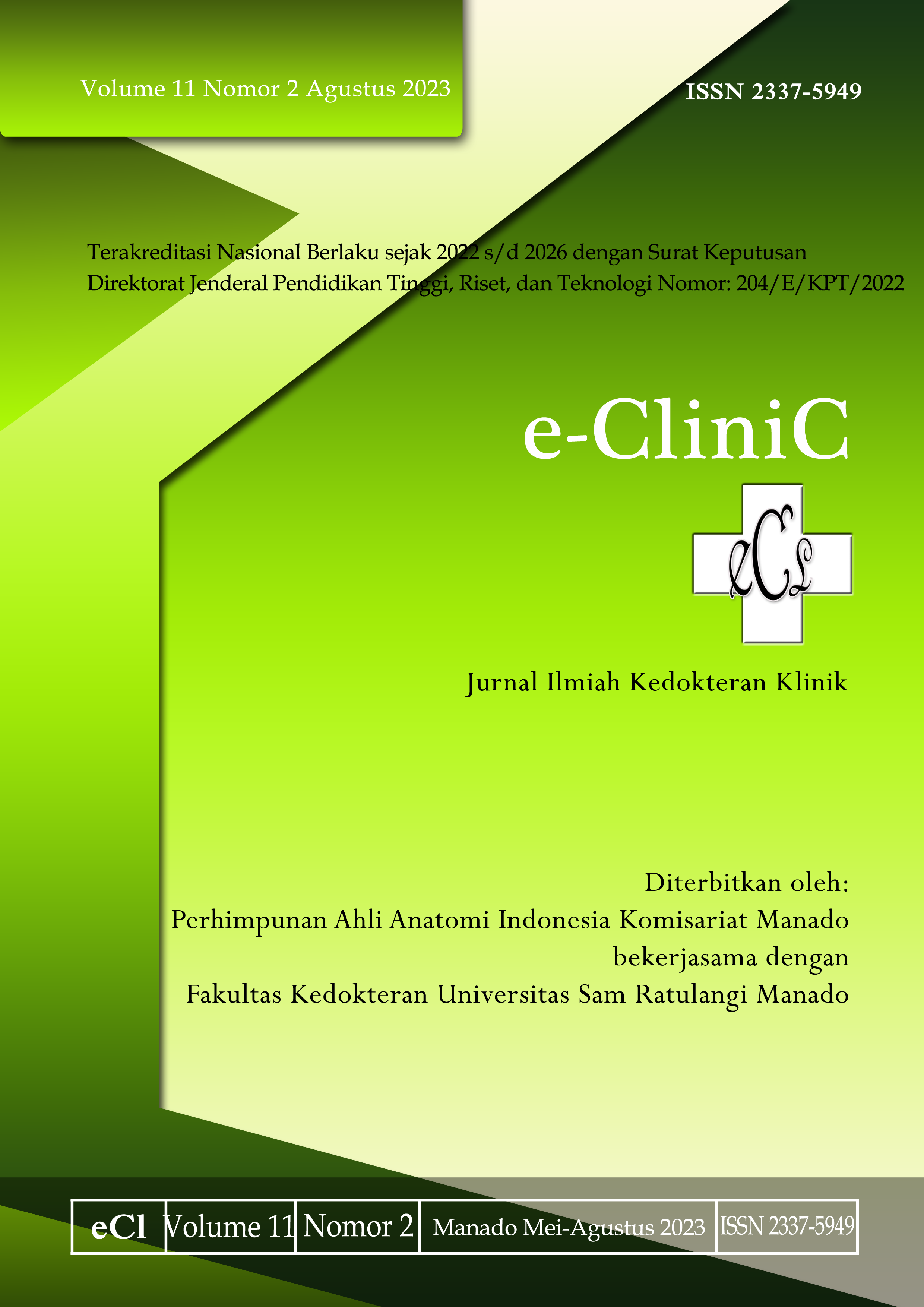Hubungan Perilaku Aktivitas Fisik dan Penggunaan Screen Time dengan Status Gizi pada Pemuda GMIM Kawangkoan
DOI:
https://doi.org/10.35790/ecl.v11i2.44903Abstract
Abstract: Today the world faces a double burden that includes undernourishment and overweight, especially in low and middle-income countries. The high intensity of screen time will cause changes in nutritional status from being fat to obesity, due to the lack of body movement in daily activities. This study aimed to evaluate whether there was a relationship between physical activity behavior and screen time with nutritional status among GMIM Kawangkoan youths. This was a quantitative study. Samples were a total population of 60 respondents. Data were analyzed univariately and bivariately with the chi square test. The results showed that the majority of respondents had poor screen time (52.6%) and poor nutritional status (56.4%). The chi square test showed significant relationships between physical activity behavior and nutritional status (p=0.006), and between screen time and nutritional status (p=0.000). In conclusion, there are significant relationships between physical activity behavior and screen time with nutritional status among youths GMIM Kawangkoan.
Keywords: nutritional status; physical activity behavior; screen time
Abstrak: Saat ini dunia menghadapi beban ganda yang mencakup kekurangan gizi dan kelebihan berat badan, terutama di negara-negara berpenghasilan rendah dan menengah. Tingginya intensitas screen time yang dilakukan akan menyebabkan perubahan status gizi menjadi gemuk hingga obesitas oleh karena kurangnya gerakan tubuh dalam aktivitias sehari-hari. Penelitian ini bertujuan untuk mengetahui adanya hubungan antara perilaku aktivitas fisik dan screen time dengan status gizi pada pemuda GMIM Kawangkoan. Jenis penelitian ialah kuantitatif. Sampel ialah total populasi berjumlah 60 responden. Analisis yang digunakan univariat dan bivariat uji chi square. Hasil penelitian mendapatkan bahwa mayoritas responden memiliki kategori screen time kurang baik (52,6%) dan status gizi kurang baik (56,4%), sedangkan responden dengan kategori aktivitas fisik baik dan kurang baik sama banyak. Hasil uji chi square tabulasi silang antara perilaku aktivitas fisik dengan status gizi mendapatkan nilai p=0,006 dan antara penggunaan screen time dengan status gizi mendapatkan nilai p=0,006 yang berarti terdapat hubungan yang bermakna antara kedua variabel tersebut. Simpulan penelitian ini ialah terdapat hubungan antara perilaku aktivitas fisik dan penggunaan screen time dengan status gizi pada pemuda GMIM Kawangkoan.
Kata kunci: status gizi; perilaku aktivitas fisik; screen time
References
WHO. 2018. Nutrition. (Online). Available from: https://www.who.int/health-topics/nutrition
WHO. 2021. Malnutrition. (Online). Available from: https://www.who.int/news-room/fact-sheets /detail /malnutrition
WHO. 2021. Obesity and overweight. (Online). Available from: https://www.who.int/news-room/fact-sheets/detail/obesity-and-overweight
WHO. 2017. A guide for population-based approaches to increasing levels of physical activity: Implementation of the WHO strategy on diet, physical activity and health: 24. Physical activity. Available from: https://www.who. int/dietphysicalactivity/pa/en/
Kementerian Kesehatan RI. 2018. Laporan Nasional Riskesdas 2018 - Repositori Badan Kebijakan Pembangunan Kesehatan (kemkes.go.id)
Kementerian Kesehatan RI. 2018. Epidemi Obesitas. (Online). Available from: http://p2ptm.kemkes.go.id/ uploads/N2VaaXIxZGZwWFpEL1VlRFdQQ3ZRZz09/2018/02/FactSheet_Obesitas_Kit_Informasi_Obesitas.pdf
Tsujiguchi T, Ito K, Sato D, Mikami J, Shiroma Y, Hasegawa A, et al. The development of an active learning program for the medical responders in a nuclear disaster. Disaster Med Public Health Prep. 2019;13(5–6):853–858. Available from: https://doi.org/10.1017/dmp.2018.168.
Asshidiqie H, Panunggal B. Perbedaan jumlah asupan energi, lemak, serat dan natrium berdasarkan kategori screen time viewing pada anak obesitas usia 9─12 Tahun. Journal of Nutrition College. 2013;2(3):403─410.
Mahali MI, Indahsari NK. Hubungan antara kebiasaan aktivitas fisik dengan indeks massa tubuh pada mahasiswa FK-UWKS angkatan 2016 dan 2017. Jurnal Medical Hang Tuah. 2019;17(1):84-92.
Welong SS, Manampiring AE, Posangi J. Hubungan antara kelelahan, motivasi belajar, dan aktivitas fisik terhadap tingkat prestasi akademik. Jurnal Biomedik. 2020;12(2):125-131.
Riskawati YK, Prabowo ED, Al Rasyid H. Tingkat aktivitas fisik mahasiswa program studi pendidikan dokter tahun kedua, ketiga, keempat. Majalah Kesehatan. 2018;5(1):26-31.
Roring NM, Posangi J, Manampiring AE. Hubungan antara pengetahuan gizi, aktivitas fisik dan intensitas olahraga dengan status gizi. Jurnal Biomedik. 2020;12(2):110-116.
Dhamayanti M, Faisal, Maghfirah EC. Hubungan kualitas tidur dan masalah mental emosional pada remaja Sekolah Menengah. Sari Pediatri. 2019;20(5):283-288.
Keswara UR, Syuhada N, Wajyudi WT. Perilaku penggunaan gadget dengan kualitas tidur pada remaja. Holistik Jurnal Kesehatan. 2019;13(3):233-239.
Putra RA, Pangestuti DR, Kartasurya MI. Hubungan aktivitas fisik dan waktu di depan layar elektronik dengan indeks massa tubuh siswa SD Islam Hidayatullah Semarang. Jurnal Kesehatan Masyarakat. 2017;5(12):255-64. Available from: https://ejournal3.undip.ac.id/index.php/jkm/article/view/ 15562.
Kumala AM, Margawati A, Rahadiyanti A. Hubungan antara durasi penggunaan alat elektronik (gadget), aktivitas fisik dan pola makan dengan status gizi pada remaja usia 13-15 tahun. Journal of Nutrition Colleg. 2019;8(2):73-80. Available from: https://doi.org/10.14710/jnc.v8i2.23816.
Ningrum DMA. Hubungan screen time dengan indeks massa tubuh pada Mahasiswa Fakultas Ekonomi dan Bisnis Universitas Muhammadiyah Surakarta. Surakarta: Universitas Muhammadiyah Surakarta; 2018.
Downloads
Published
How to Cite
Issue
Section
License
Copyright (c) 2023 Melita A. Lolowang, Aaltje E. Manampiring, Bernabas H. R. Kairupan, Welong S. Surya

This work is licensed under a Creative Commons Attribution-NonCommercial 4.0 International License.
COPYRIGHT
Authors who publish with this journal agree to the following terms:
Authors hold their copyright and grant this journal the privilege of first publication, with the work simultaneously licensed under a Creative Commons Attribution License that permits others to impart the work with an acknowledgment of the work's origin and initial publication by this journal.
Authors can enter into separate or additional contractual arrangements for the non-exclusive distribution of the journal's published version of the work (for example, post it to an institutional repository or publish it in a book), with an acknowledgment of its underlying publication in this journal.
Authors are permitted and encouraged to post their work online (for example, in institutional repositories or on their website) as it can lead to productive exchanges, as well as earlier and greater citation of the published work (See The Effect of Open Access).







